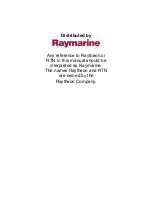
www.good-lite.com | 1.800.362.3860 | 1.888.362.2576 fax
1
HOTV Near Vision Card
Part Number: 731000
Near vision is functionally more important than distance vision
in the life of a young child. The child is also more accustomed
in using vision at near than at greater distances. Therefore
introduction of the test situation at near familiarizes the child with
the test situation. You learn also about the child’s functional vision:
In the rare case of myopia you will find that the child has useful
vision at near and parents will not be alarmed when the child does
not see well during the distance visual acuity test.
When examining normally sighted children, hold the card at
40cm/16", the length of the cord. Let visually impaired children use
their preferred distance and head posture during the first testing,
later measure at 40cm/16" if the child also uses that distance in
visual tasks.
Testing Procedure
•
Establish a method of communication such as naming
(signing) or pointing (matching). When needed, train with
the
HOTV Response Panel
(#700523), or
Flash Cards
(#700515).
•
Start with binocular testing, using the center grouping of letters.
•
Point to each of the four letters (HOTV) on the top line,
observe the baseline responses for comprehension, speed
and accuracy.
•
Cover the top line with a white card (the reverse side of
a flash card may be used). It is best not to cover the top
line completely, but to leave the bottom half of the letters
exposed. (This maintains the “contour interaction” effect of the
standardized chart layout. If this confuses the child, cover the
top line completely.)
•
Ask the child to identify only the first letter on the line below
the covering card.
•
Repeat this procedure for each or every second line (moving
quickly down the chart to avoid tiring the child) until the child
hesitates or misidentifies a letter.
•
Move back up one line and ask the child to identify all the
letters on that line.
•
If the child identifies all letters correctly go to the next line
down and ask the child to identify all the letters on that line.
•
If the child skips a letter, ask the child to try again while briefly
pointing to that letter.
•
The visual acuity is recorded as the last line on which at
least 3 of the 5 letters are read correctly. Always test until the
threshold line.
•
If the chart is held at 40cm (16 in) the visual acuity value is
found in the margin adjacent to that line.
•
After binocular testing, proceed with testing each eye
separately. When the right eye is covered ask the child to
identify the letters grouped on the lower left of the card (lower
right when the left eye is covered). Use two pairs of plano
glasses for occlusion of the child’s eyes or a pair of symmetric
glasses that can be used for covering both eyes, one at a
time. This is the least disturbing type of occluder for children.
•
For monocular testing, follow the same procedure as for
binocular testing.
Monocular near vision testing
Monocular near vision values are important in the follow-up of
amblyopia treatment. Visual acuity values often improve first at
near and later at distance. Before the age of three years it is usually
easier to measure monocular near vision values than distance
visual acuity values.
As a part of vision screening monocular testing is of interest at
the age of 6-7 years. If visual acuity at distance has become less
than it was at age 4 or if there is difference between the two
eyes, near vision measurement may give the following diagnosis:
If the near vision values are symmetric and as before the change
in distance vision cannot be caused by anything else but mild
myopia, which does not need to be corrected. The child does not
need to be referred. This leads to a decrease in the expenses of
vision screening and simultaneously an improvement in the quality
of screening.
Testing Near Vision at Shorter Distances
A child with a visual impairment is allowed to choose any distance
and is given a correction for that distance, if needed. If the chart
is used at a distance other than the usual 40cm (16 in)+, measure
and record the viewing distance and the letter size read (the M
value) or the visual acuity value printed adjacent to the
threshold line.




















